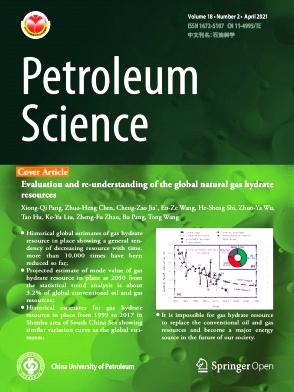热成熟过程中有机-无机转化和相互作用对富有机质页岩纳米孔赋存的影响——来自封闭系统中含水热解实验的启示
IF 6.1
1区 工程技术
Q2 ENERGY & FUELS
引用次数: 0
摘要
富有机质页岩热成熟过程中,有机-无机转化和相互作用对纳米孔的形成起着关键作用。以松辽盆地上白垩统嫩江组富有机质泥岩为研究对象,在封闭体系下进行了含水热解实验。热解页岩的孔隙类型、孔隙网络及有机、无机组成在早期至过成熟阶段(%Ro = 0.61 ~ 4.01)均有明显变化。实验结果表明,有机质和矿物的地球化学转化及其相互作用控制着纳米孔隙的形成和演化。油窗内矿物基质孔隙被生成油充填,有机酸溶解钾长石促进粘土伊利化形成伊利石,有机质与粘土复合体中粘土(如伊利石)的催化作用可促进原位滞留油裂解生成天然气,导致油窗内复合体中有机质孔隙较早出现。由于固体干酪根发生明显的初次裂解,生成可提取的液体油,储液孔隙体积持续增大,在油窗结束时接近最大值。在气窗中,原油的剧烈裂解有利于烃源岩和焦沥青地层的运移,导致改性矿物基质孔隙和有机质孔隙的大量出现。在%Ro = 1.36-2.47时,烃类储集孔隙体积略有减小,这是由于石油次生裂解形成的焦沥青所致。有机-无机相互作用有利于粘土的钝化、石英的溶解、黄铁矿和碳酸盐的分解,有利于纳米孔隙的形成。杂岩中含有伊利石和有机质的焦沥青比含有改性矿物基质孔隙和微裂缝的焦沥青多孔得多。粘土的催化作用被认为是造成这种现象的原因。该研究提高了我们对富有机质页岩热成熟过程中纳米孔隙形成演化途径及控制因素的认识,有助于评价沉积盆地中页岩油和页岩气的甜点区。本文章由计算机程序翻译,如有差异,请以英文原文为准。
Effects of organic-inorganic transformation and interaction on the occurrence of nanopores within the organic-rich shale during thermal maturation: Insights from the hydrous pyrolysis experiments in a closed system
The organic-inorganic transformation and interaction act as the critical role in the occurrence of nanopores within the organic-rich shales during thermal maturation. Hydrous pyrolysis experiments were conducted on the organic-rich mudrock collected from the Upper Cretaceous Nenjiang Formation of the Songliao Basin, China in a closed system. The pore types and pore network, and organic and inorganic compositions of pyrolyzed shales were detected from the early to over mature stages (%Ro = 0.61–4.01). The experimental results indicate that geochemical transformation of organic matters and minerals and the interaction control the formation and evolution of nanoporosity. In oil window mineral matrix pores are infilled by the generated oil, K-feldspar dissolution by organic acids promotes clay illitization to form illite, and the catalytic effects of clays (e.g. illite) in the complex of organic matter and clays may promote the in-situ retained oil cracking to generate natural gas, resulting in the early occurrence of organic-matter pores in the complex within oil window. Due to significant primary cracking of solid kerogen to generate extractable liquid oil, pore volume for storing fluids presents a persistent increase and approaches the maximum at the end of oil window. In gas window intensive oil cracking facilitates the hydrocarbon migrating out of the source home and pyrobitumen formation, resulting in the significant occurrence of modified mineral matrix pores and organic-matter pores. Pore volume for hosting hydrocarbons presents a slight decrease at %Ro = 1.36–2.47 due to pyrobitumen formation by oil secondary cracking. The organic-inorganic interaction favors clay illitization, quartz dissolution, and pyrite and carbonate decomposition, which facilitate the occurrence of nanoporosity. Pyrobitumen within the complex with illite and organic matters are much more porous than that hosted in modified mineral matrix pores and microfractures. The catalytic effects of clays are supposed to be responsible for this. This study improves our understanding of the formation and evolution pathways of nanoporosity and the underlying controls in organic-rich shales during thermal maturation, and hence should be helpful in evaluating the sweet spots for shale-oil and shale-gas plays in a sedimentary basin.
求助全文
通过发布文献求助,成功后即可免费获取论文全文。
去求助
来源期刊

Petroleum Science
地学-地球化学与地球物理
CiteScore
7.70
自引率
16.10%
发文量
311
审稿时长
63 days
期刊介绍:
Petroleum Science is the only English journal in China on petroleum science and technology that is intended for professionals engaged in petroleum science research and technical applications all over the world, as well as the managerial personnel of oil companies. It covers petroleum geology, petroleum geophysics, petroleum engineering, petrochemistry & chemical engineering, petroleum mechanics, and economic management. It aims to introduce the latest results in oil industry research in China, promote cooperation in petroleum science research between China and the rest of the world, and build a bridge for scientific communication between China and the world.
 求助内容:
求助内容: 应助结果提醒方式:
应助结果提醒方式:


